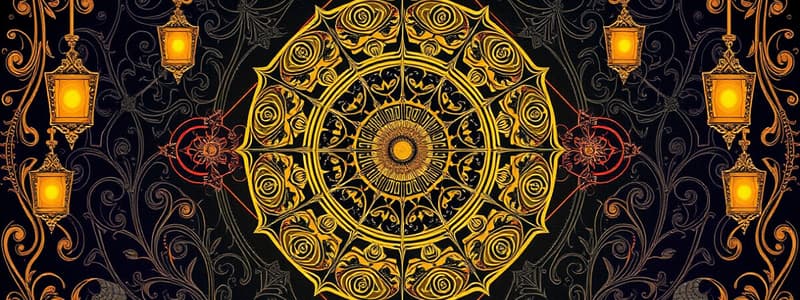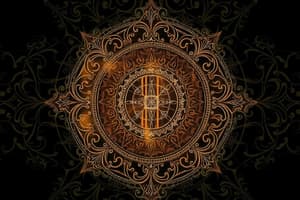Podcast
Questions and Answers
Which base represents the binary number system?
Which base represents the binary number system?
- 10
- 8
- 2 (correct)
- 16
The octal number system uses the symbols 0 to 7.
The octal number system uses the symbols 0 to 7.
True (A)
What is the value of the hexadecimal number 'A' in decimal?
What is the value of the hexadecimal number 'A' in decimal?
10
A collection of 8 bits is called a ______.
A collection of 8 bits is called a ______.
Match the number systems with their base:
Match the number systems with their base:
Which number system is primarily used by humans?
Which number system is primarily used by humans?
The hexadecimal number system uses symbols beyond 0 to 9.
The hexadecimal number system uses symbols beyond 0 to 9.
What two fundamental digits are used in the binary number system?
What two fundamental digits are used in the binary number system?
What is the decimal equivalent of the binary number 101011₂?
What is the decimal equivalent of the binary number 101011₂?
The weight for the binary bit furthest to the left is always zero.
The weight for the binary bit furthest to the left is always zero.
What is the method used to convert octal numbers to decimal?
What is the method used to convert octal numbers to decimal?
To convert hexadecimal to decimal, multiply each bit by ____ raised to the power of its weight.
To convert hexadecimal to decimal, multiply each bit by ____ raised to the power of its weight.
Match the number system to its base:
Match the number system to its base:
Which of the following best describes the process of converting decimal to binary?
Which of the following best describes the process of converting decimal to binary?
The octal number 724₈ converts to 468₁₀ in decimal.
The octal number 724₈ converts to 468₁₀ in decimal.
Calculate the decimal value of the hexadecimal number ABC₁₆.
Calculate the decimal value of the hexadecimal number ABC₁₆.
What is the binary representation of the decimal number 117?
What is the binary representation of the decimal number 117?
What is the octal equivalent of the decimal number 1234?
What is the octal equivalent of the decimal number 1234?
The 10’s complement of 3675 is 6324.
The 10’s complement of 3675 is 6324.
The binary equivalent of the octal number 705 is 111000101.
The binary equivalent of the octal number 705 is 111000101.
If the value of 'k' in base 2 is 1024, what does it represent in terms of memory?
If the value of 'k' in base 2 is 1024, what does it represent in terms of memory?
The ____’s complement of a number is obtained by subtracting the number from the power of the base.
The ____’s complement of a number is obtained by subtracting the number from the power of the base.
What is the hexadecimal equivalent of the decimal number 1234?
What is the hexadecimal equivalent of the decimal number 1234?
The binary representation of the hexadecimal number 10AF is ___
The binary representation of the hexadecimal number 10AF is ___
Match the following prefixes with their values:
Match the following prefixes with their values:
What does the symbol 'M' represent in computing?
What does the symbol 'M' represent in computing?
Match the following conversion techniques with their descriptions:
Match the following conversion techniques with their descriptions:
What is the octal equivalent of the binary number 10101111?
What is the octal equivalent of the binary number 10101111?
The complement of a number is always a positive value.
The complement of a number is always a positive value.
To convert a binary number to hexadecimal, you group bits in fours.
To convert a binary number to hexadecimal, you group bits in fours.
What is the formula for calculating r’s complement?
What is the formula for calculating r’s complement?
What is the octal equivalent of the binary number 110110?
What is the octal equivalent of the binary number 110110?
The hexadecimal number 1F0C is equivalent to the octal number ___
The hexadecimal number 1F0C is equivalent to the octal number ___
The result of converting the decimal number 33 to binary is:
The result of converting the decimal number 33 to binary is:
What is the first step in finding the (r-1)'s complement using the shortcut method?
What is the first step in finding the (r-1)'s complement using the shortcut method?
The binary 1's complement requires you to leave the digits unchanged until the first 1 is encountered.
The binary 1's complement requires you to leave the digits unchanged until the first 1 is encountered.
Calculate the 10's complement of (529400)10.
Calculate the 10's complement of (529400)10.
(A4D7E0)16 gives r's complement of ______ when calculated.
(A4D7E0)16 gives r's complement of ______ when calculated.
Match the numbers with their corresponding r's complements:
Match the numbers with their corresponding r's complements:
Flashcards are hidden until you start studying
Study Notes
Introduction to Number Systems
- Base denotes the fundamental symbols in a numbering system (e.g., 0, 1, 2).
- Common numbering systems include:
- Decimal (Base 10)
- Binary (Base 2)
- Octal (Base 8)
- Hexadecimal (Base 16)
Common Number Systems
- Decimal (Base 10): Used by humans, symbols 0-9, not used by computers.
- Binary (Base 2): Symbols 0, 1; used by computers, not by humans.
- Octal (Base 8): Symbols 0-7; not used commonly, useful for representing long binary numbers.
- Hexadecimal (Base 16): Symbols 0-9, A-F; also useful for representing long binary numbers.
Counting in Different Bases
- Values of decimal, binary, octal, and hexadecimal representations are established.
- Example conversions show a range from 0 to 20.
Bits and Bytes
- A bit is the smallest unit in binary, while a byte is a collection of 8 bits.
- Binary system consists of two digits: 0 and 1.
Conversion Among Bases
- Techniques for converting between decimal, binary, octal, and hexadecimal systems are highlighted.
- For decimal representation, the weight or position of the digit affects its value exponentially based on the base.
Binary to Decimal Conversion
- Multiply each bit by 2 raised to the bit's position (weight).
- Sum all values to get the decimal equivalent.
Octal to Decimal Conversion
- Multiply each octal digit by 8 raised to its position.
- Add the results for the decimal output.
Hexadecimal to Decimal Conversion
- Multiply each hexadecimal digit by 16 raised to its position.
- Sum the products to convert into decimal.
Decimal to Binary Conversion
- Divide the decimal number by 2, recording remainders.
- The sequence of remainders gives the binary representation.
Decimal to Octal Conversion
- Divide the decimal number by 8, keeping track of remainders.
- The remainders will form the octal output.
Decimal to Hexadecimal Conversion
- Divide the decimal number by 16 and track the remainders.
- The sequence will give the hexadecimal representation.
Octal to Binary Conversion
- Convert each octal digit into its 3-bit binary equivalent.
Binary to Octal Conversion
- Group binary digits in sets of three, converting each group to an octal digit.
Hexadecimal to Binary Conversion
- Convert each hexadecimal digit to its 4-bit binary equivalent.
Binary to Hexadecimal Conversion
- Group bits in sets of four and convert each group to a single hexadecimal digit.
Octal to Hexadecimal and Vice Versa
- Use binary as a bridge for conversion between octal and hexadecimal formats.
Common Powers of 10 and 2
- Base 10 prefixes include pico, nano, micro, milli, kilo, mega, giga, and tera with respective values.
- Base 2 prefixes like kilo, mega, and giga have specific values relevant in computing.
Complement
- The complement of a number provides its negative equivalent.
- Two types of complements exist for a base: r's complement and (r-1)'s complement.
Finding r’s and (r-1)’s Complements
- r’s complement of a number is found using the formula r^n - N.
- (r-1)’s complement is calculated as r^n - N - 1.
- Shortcuts exist for finding complements, simplifying the process, especially in binary.
Examples of Complement Calculations
- Various examples illustrate how to compute complements in different bases using both the standard method and shortcuts, demonstrating practical applications.
Studying That Suits You
Use AI to generate personalized quizzes and flashcards to suit your learning preferences.





